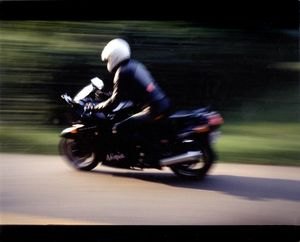Newly Pumped in the Aftermarket,
"An old nail," is what the loopy Britbike mags would call my '92 Kawasaki ZX-11.
Even the bike's latest iteration, the ZZR-1200, has come in for punishing prose along the lines of "Ho-hum, not much new here." Well, bollocks-n-buggery! Fact is, thanks to the robust aftermarket (and that in turn to the loyalty of ZX-11 Fans), the original 1989-1999 ZX-11 Ninja still has a lot to offer. A quick browse through cyberspace says it all. Several very active 'sites are devoted to the bike, examining just about every stressed bolt, layshaft and oil pan - stock and modded. Just search Google for "ZX-11" and see for yourself.
My big buddy is an early "C" model, with a middling 45,000 miles (I know of 80,000+ mile examples). Most of that's from touring and commuting, with the odd sidewall-scuffing mountain workout thrown-in, to avoid boxy tires and squidlet derision. So what, if it gets put away wet from time to time? Sometimes it even gets a little air under the (front) tire when we're feeling spunky. However, respect for the bike's and my own age, means that I ride it like the sporty tourer it is - not the "sport bike" that the factory press kit proclaims - and yeoman service it has delivered, too.
The cases have never parted and the Do-Not-Mess quotient remains high for my Black Torpedo. Still, with the miles adding up, restorative work was indicated. The OE suspension was getting thwacked to death, compliments of the moonscape that passes for "roads" in Washington DC and environs. The measure was the bodywork, which creaked ever louder over the landscape's various whoops-n-ruts.
California-based Race Tech came to the rescue with brilliant suspension upgrades. Well OK, he -Pete Payne of Heavy Duty Racing, a Race Tech distributor in Stafford, Va.- cleared the smarmy soup out of the fork innards, gave the internals a scrub bath and made room for RT's famous "Gold Valve" Cartridge Emulators. The fork's preload adjusters would stay, but the now useless rebound damper rods were sawn-off per instructions. Race Tech took my 6'4", 195-pound dimensions and moderate riding style into account and sent the correct spring rates to suit.
These suspension upgrades have reduced the bodywork noise to insignificance and erased the bike's mild tendency to pogo. Here was a more city-friendly and secure-feeling Ninja.
Furthermore, the dialable suspension allows safer escapes from u-turning cabbies, lunch-munchers, cell phone yakkers, breast-feeding moms and other caged dim bulbs. The new setup also helps in faster, bumpy sweepers, easing the need for the steering damper I'd considered. In summary, the bike is a lot more composed and boasts improved front-end feedback, which has never been a Big K strong suit. This is all grand, because spring preload changes remain a hellish, wheel-removing proposition.
I said more composed, not "faster". Somehow, our high-speed couch demanded beefier thrust to propel it down those newly smoothed roads. Motad would help redress this deficit. Based in Britain, they make super-durable exhausts for a startling variety of bikes dating back to the 1970s. But then they'd have to, given the UK's shite weather and salty, metal-pitting air.
Off came the heavy OE exhaust pipes and on went the gorgeous -but just as heavy- replacement Nexxus full system. Damn! I'd pined away for the handling improvement a friend's stock ZX-11 received after installing an excellent sounding, 20 Lb. lighter, V&H SS-2 four-into-one system. Sigh, no matter, along with similar looks and configuration to the factory 4-into 2 system -which I liked for symmetry's sake-, Motad bragged of major HP gains from its Nexxus system.
To see if Motad's claims stand-up in the real world, Big Black was first run on a Dynojet 150, with the stock exhaust. The result was a keenly disappointing 117Hp. Maybe it was the California anti-emissions plumbing, which I'd never bothered to remove? The wrong header pipe gaskets maybe (none came from Motad, so an old-model GPz 1100's were scrounged)? Perhaps, just maybe, I shouldn't worry too much. Talks with other owners and shop wrenches revealed that "C" model ZX-11 Ninjas typically range from a low of 116Hp. at the tire, to a high of 128Hp. Victory! In a half-dozen pulls, the Motad gave a stonking nine-hp gain to 127.8Hp. @ 10,000 Rpm.
Right, with the Motad importer anxiously hovering about, mechanic and race tuner Mike Langlois -Langlois Performance Engineering, Beltsville, Md.- lost the fairing, eased off the OE plumbing and installed the new exhaust system with the scavenged gaskets. Victory! In a half-dozen pulls, the Motad gave a stonking nine-hp gain to 127.8Hp. @ 10,000 Rpm. Just as importantly, almost nothing was lost down low. With replacement systems or slip- on cans typically yielding increases of just 4-6 Hp. in magazine comparos, we were quite pleased, and Motad Man was vindicated. This is really quite surprising, since once again, the California plumbing stayed put and there was no fiddling with carb tops, needles or a jet kit. No tuning! According to "Throttle Bob," (who dynos bikes at a large dealership during Daytona's Speed Week), those additional tweaks are good for another 6-8Hp. I really wouldn't object to my ancient stormer yielding an honest 137Hp. at the tire. On top of those gains, I could probably gain three more, with an additional ram-air tube up front. (The porkier "D" model ZX-11s needed a twin-tube set of Ram-Air intakes).
So, now we are making more power, and courtesy of the new legs, we're doing it with enhanced grace, safety and comfort. Next comes more Stop to balance the Go. The stock pads in the four-pot Tokico calipers have proven themselves mostly fine, although panic stops from 80 or 90 MPH sometimes lurched perilously close to trouser filling. We'd therefore swap them out for a set of Galfer's "Black" pads. We've found these to be solid performers for a few years, especially when used in tandem with Galfer's nifty braided steel brake lines. Lately, a set of EBC pads has enjoyed a comfy life in those same stock Tokico calipers. The EBCs seem to give excellent power and more consistent results for all-condition riding.
Our Ninja is now a faster, better-behaved, quicker stopping and more civil relic. Still, sometimes you have to say goodbye to civility and get down! I mean, at least to the extent that a near-600 Lb. machine and 200 Lb. rider on the wrong side of fifty can.
Our Ninja is now a faster, better-behaved, quicker stopping and more civil relic. Still, sometimes you have to say goodbye to civility and get down!
Time may march, crawl or skid along. However, in terms of advances in rubber technology, warp-speed is more like it. As aficionados of classic 1960s-1980s bikes know, tire tech has jumped way ahead since then. It was the late '70s and 1980s, when 100+ Hp. Japanese race bikes shredded the era's rubber, and tire and chassis manufacturers scrambled to keep up with the power. (Ask Messrs. Roberts, Spencer and Lawson.) A modern Avon Super Venom, for example, really transforms the handing of old Norton Commandos, Ducati 750 Super Sports and other 1970s icons. Could the differences be as dramatic in this instance? We'd spoon on a pair of Bridgestone's BT-012s and see for ourselves. The company hails the skins as a big step forward. Enough so, that it's a popular replacement tire for my ZX-11's nephew, the awesome ZX-12.
Let's get cracking then! After putting just over 700 miles on the BT-012s, the profiles are still rounded with no appreciable wear showing. Now, I'm yearning for the "chicanery" that only our Top-Secret test circuit -a favorite state park hereabouts- can offer. We go for it, arcing up hills, down dales, through decreasing radius and off-camber turns by the dozens. Put up wet, indeed! So, are the BT-012s the dog's bollox? The magazine comparos say no; Cycle World (Aug. '03) rated them in the lower-middle of the pack. Maybe so, but considering what I've been used to, the newer, grippier tires make a noticeable and welcome difference. Now, I'm not quite up for a track day with Sean yet, or for sewing elbow sliders on my Aerostich jacket. However, the ballistic nylon knees of my pants are in immediate peril! I'm more confident for sure. Transitions are easier and faster, and corner exit speeds are higher. There's also a little less tendency to stand up when trail-braking. Where are the duct tape and a couple of old hockey pucks, when you need them?
With the ZX-11 energized with some extra power, improved suspension, handling, brakes and tires, a new perch is in order. After all, we've been Speed Weeking down the East Coast to Daytona, for several years straight (Each time enduring a 12 hour first day leg). Sympathetic to the cries from my backside, Corbin provided the "Gunfighter" seat with optional backrest.
It took an exasperating 1,200 miles to break-in ("Be patient!" the Corbin Man kept saying), but since then, the saddle has been comfort personified. In addition, the passenger seat doubles as a racers' bum-stop for those adrenaline-charged mid-afternoon dashes over to the girlfriend's pad, before the kids come home from school. When in place, the backrest makes passengers feel a lot more secure (although ZX-11s have a nice grab bar), is a good place to stow the passenger's helmet and, for touring, an additional lashing point for gear.
Speaking of gear, as a matter of course, I leave Bagster's capacious gas tank bag clipped securely onto the same their full sized, plush-lined tank cover. Inside the bag, are a good first-aid kit, disk lock (Bic pen anyone? -Sean), spare-in-a-can, bulletproof CruzTools, spare cash, air pressure gauge and the usual miscellany. It's not pretty, just practical. For weekend trips or longer sojourns, the French-made top bag gets zipped on, making it a double-decker. Both have map pockets and wear like iron. A rain cover emerges from a zipped pocket if need be. It's a cool setup, even for Francophobes.
For the Daytona excursions, Givi's helmet-gulping, grommet-sealed, "Monokey" hard bags are de rigueur. They Open/Close, Install/Remove instantly with the same key. I chose the Givi 36-liter bags, you might go for the bigger ones -they come up to 50-liters per side- A third box can be added if you have the optional top-rack. Molded in thermoplastic, they're rugged as hell and such high quality that some major OEMs re-badge and offer them as factory touring accessories.
Thus equipped are we -as many a magazine Editor is wont to comment- "Stylin! " ? Don't repeat this, but fully loaded (including my comely lass), we chased a sports car through sparsely-traveled rural Virginia at and indicated 138 mph, until we spied a state trooper writing up the sports car we'd previously diced with! I might've been sweating, but the bike was dead stable.
-A New Lid To Accompany My Upgraded Steed-
The last item is a bit of vanity, un petit fripperie you could say (but probably wouldn't). Shoei -one of two virtual Paris Guns of the helmet industry-, released a lid fittingly called the X-Eleven. Since I've been tootling around on my own 'X-11 wearing a helmet of like vintage -Shoei's old X-9- we thought it useful to discover whether skid lid tech has come as far as the replacement gear's modernized the bike. The short answer is: Yes! Although not noticeably lighter than the earlier 'lid, the 'Eleven boasts marvelous a detail, the venting. August in the nation's capital is a grim time, a real steam bath. You don't want to arrive at the local cafe in search of "The Other Gender", then remove your head sauna, I mean helmet. The coiffeurs gone to Hell, and the aroma has all of the hot prospects fleeing.
Although they look tiny, the vents on this helmet really work amazingly well. Even at 20-25 mph the air's channeled in, moved to the back and exits out with real efficiency. It's all about strategic placement, Shoei says. The company also boasts that the helmet is quiet (It is quiet for a vented helmet -Sean). Maybe so, but my integral head-mounted decibel-o-meters put the noise level down about 15% compared to my old X-9. As for the swoopy fastback fin running down the back, that's meant to curb buffeting and it really works. Even when the wind had the rest of me flapping around -armored Aerostich jackets are w-i-d-e-, there seems a magical dead-air zone around the helmet. This saves your neck and keeps you from bobbing down the road idiotically like one of those bobblehead toys you see on the rear deck of White Trash cars.
You don't want to arrive at the local cafe in search of "The Other Gender", then remove your head sauna, I mean helmet.
I also like the easily-removable padding. As for the shield, it's the same easy to remove scratch-resistent item as the X-9's. The fit is excellent, although the chin bar doesn't come down as far over the chin as the earlier helmet. Mind you, how effective the buffeting, noise levels, venting and overall fit are depend a lot on your head shape. It is always a good idea to try on helmets at a dealer. And, IMHO, to buy it there too, rather than waste the shop's time, then go and buy through the 'net. Don't be a cheapskate! Support your local dealer or you and your buds will soon find 'em gone. Then, try to collect your refund from Cyberspace!
In the future, we'll have LOUDER horns (Niccos? Fiamms?), carb tuning and valve adjustments (finally), and perhaps a good bench-flowing and 5-angle valve job. I can also see a sprocket exchange in our future, to boost mid-range response, at the expense of top speed and an increase in highway revs. I dunno about your area, but the places in mine where 100-plus was natural in the early-to-mid '90s are disappearing with alarming speed. OTOH, a Power Commander module is a maybe and I still want to do that extra ram-air tube with modified airbox to match. Then again, is West Tech Engineering's Jim Newkirk ever going to get that turbo unit to us, for our 200-plus MPH Bonneville runs? One just never knows with these things.
In short, the changes wrought to my bike help a lot. Granted, today we see a plethora of dandy sport-tourers, ones that allow very zesty and possibly better handling (though not faster!) rides for their owners. I like the FZ-1 Yamaha and SV1000 V-twin, for instance. Yet, the essential traits of the ZX-11 allow even early ones like mine to continue to shine brightly. But that is as you'd expect. The Big Ninja debuted in 1989, was an instant classic, and remained in the Kawasaki lineup for an almost unheard of ten years. Maybe you too, have a great bike that fits like a glove and is dead reliable, a true keeper. Hey, don't dump it - pump it!
ZX-11 Aftermarket Contacts & Prices
RACE TECH:
Fork Gold Valve kit: $159.99
Fork springs: $109.99
Oil: $ 24.99/qt
Shock Gold Valve kit with remote reservoir: $279.99
Shock spring: $119.99 if needed
Race Tech Inc.
1501 Pomona Rd
Corona, CA 92880
Phone: (909) 279-6655
GIVI:
GIVI injection-molded 36-L saddlebags with brackets-
Wingrack fitting kit for '90-'92: part # Y406 $84.20
Wingrack for 3 cases: part # N141 $150.50
Wingrack fitting kit ZX11 '90-'92: part # Y406 $84.20
Wingrack fitting kit ZX11 '93-'96: part # Y411 $112.00
Wingrack for three cases: part # N141 $150.50
Wingrack for sidecases only: part # N151 $96.20 (a Wingrack bridge kit will be needed with this kit, it is part # Y100 $36.40)
Sidecases: part # E360N $202.90 each
Sidecases: part # E36N $179.50 each
GIVI USA Motorcycle Accessories
805 Pressley Road, Suite 101
Charlotte NC 28217
Phone: (877) 679-GIVI
Fax: (704) 679-4133
Email: [email protected]
PIAA:
H4 "Xteme White Plus" powersport bulb, 60/50 Watt, 4000 Kelvin, Twin-pack $75.00
BAGSTER:
Omega #9 37Liter (two bag combo, PVC.nylon) Maybe you too, have a great bike that fits like a glove and is dead reliable, a true keeper. Hey, don't dump it - pump it!
Purchased From:
Euro Bikes
Manassas, Va.
(703) 257 9500
http://www.eurobikes.com/
GALFER:
Braided Brake Line & Pad Kit $95.00
EBC:
Set of front brake pads $63.00
ZERO GRAVITY:
Aftermarket Windscreen $75.00
MOTAD:
NEXXUS full exhaust system $400.00
£440 +VAT.
CORBIN:
Gunfighter Saddle $349.00
Gunfighter Backrest $219.00
PRO GRIPS:
Gel "soft" Grips $11.00
Step-By-Step Suspension Mods
More by David C. Walsh





































Comments
Join the conversation